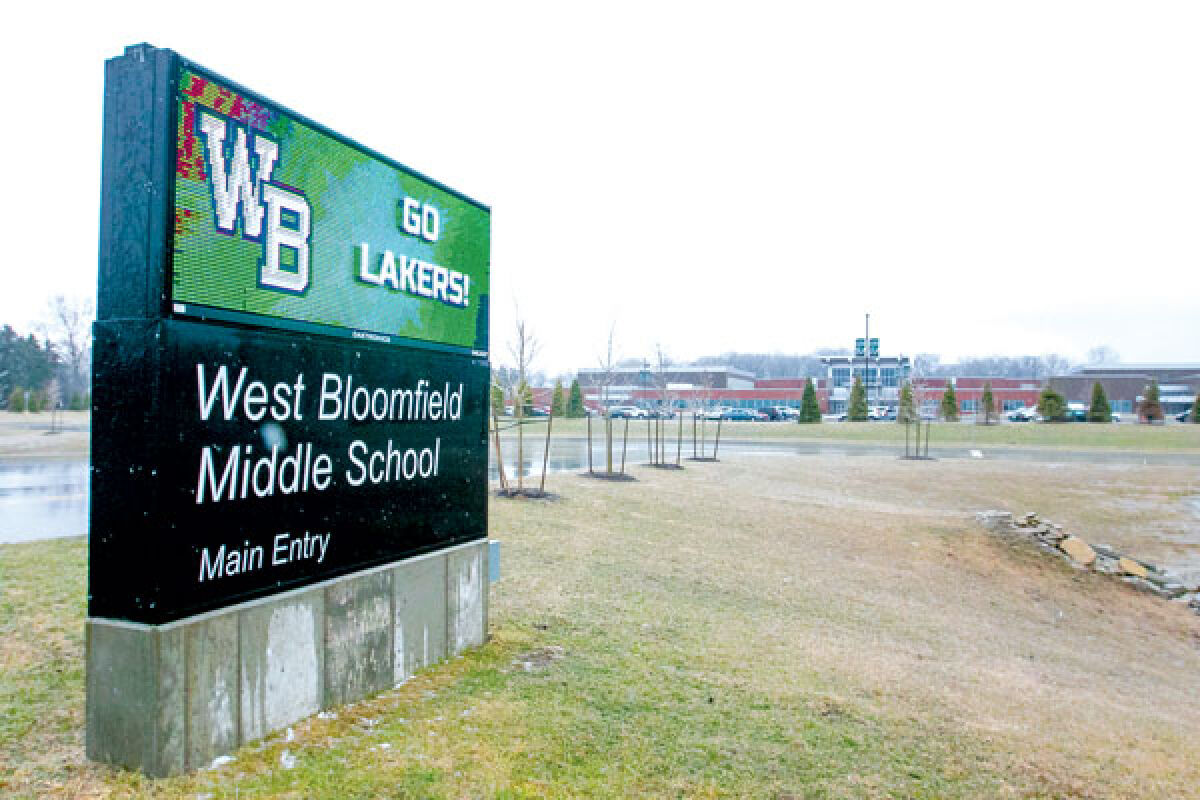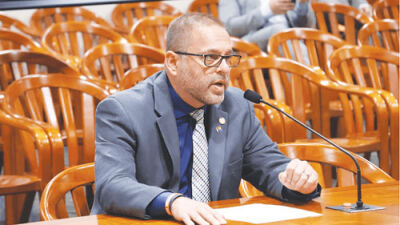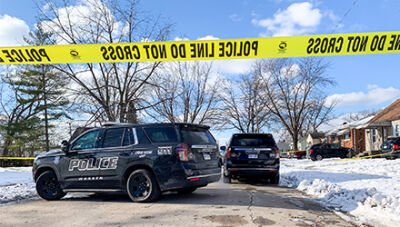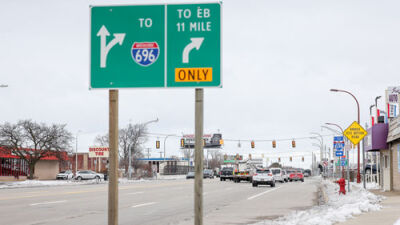
West Bloomfield School District Superintendent Dania Bazzi, left, and West Bloomfield Middle School Principal Amy Hughes are pictured at West Bloomfield Middle School Feb. 27. The West Bloomfield School District is seeking a $148 million bond proposal as part of an election set to take place in May.
Photo by Patricia O’Blenes

Residents will have an opportunity to cast their votes later this year. Pictured is the strings room at West Bloomfield Middle School.
Photo by Patricia O’Blenes

After using a large portion of money from a bond proposal that was approved in 2017 for the completion of West Bloomfield Middle School, voters have a new bond proposal to consider from the West Bloomfield School District.
Photo by Patricia O’Blenes
WEST BLOOMFIELD — The West Bloomfield School District is seeking a $148 million bond proposal, and voters will have an opportunity to decide whether or not to approve it at a special election in May.
District officials say the bond would be used for “high-priority capital improvements,” such as two new elementary buildings; science, technology, engineering, art, mathematics and career technical training space; multi-activity spaces; technology upgrades; and dedicated early childhood spaces.
Officials are emphasizing that an approval would not amount to a tax increase over last year’s taxes for residents, due to other expiring debt levies.
If approved, the proposal would extend the current millage rate of 6.15 mills to 2032. A levy of 1 mill is equal to $1 for every $1,000 of a home’s taxable value.
If the measure were to fail at the polls, taxpayers would not be levied the proposed bond’s estimated annual levy of 3.27 mills.
“The May 2023 bond proposal is a result of a master facilities plan that the district conducted, along with the work of (a) building futures committee, to come up with, what are some immediate needs within the district, as well as some wants for the future,” said West Bloomfield School District Superintendent Dania Bazzi. “The bond really focuses on elementary programming, as well as high school, career, technical and STEAM programming, like, basically, robotics, engineering and career and technical fields. … Also, it includes … the insides of the building, things that people don’t see, but are needed, like mechanical, plumbing, electrical, boilers, roofing – things that, obviously, are needed to maintain a school district. … Michigan is one of seven states that does not include capital improvements in their public school funding, so that’s why districts go out for bonds.”
Bazzi shared the rationale for the timing of the proposal.
“It’s a $148 million bond, but with a zero estimated net increase, which is important, because right now, going out for a bond at this particular time would allow us the zero net increase,” she said. “Our debt tax rate, currently, is at 6.15, and because it’s set to go down, holding it at the current rate would allow us to capture approximately $148 million with a zero estimated net increase.”
Keego Harbor resident David Emerling took issue with the way that the proposal has been presented.
“They, in my eyes, have misled the public by saying this is a non tax increase (proposal), because they’re saying there’s no increased millage,” Emerling said. “What they’re not saying is that the current five-year millage will ramp down, literally, in June.” He said that renewal or replacement millages have higher success rates.
The timing of the bond proposal has also gotten Emerling’s attention, noting that special elections come with a cost to conduct.
“(It) costs $70,000, and they added about $50,000 of money for advertising for this thing; so, $120,000 for a special election,” he said. “So, $120,000 is not going to education.”
Kendra Montante is the public relations and marketing coordinator for the West Bloomfield School District.
“So, there are costs associated with running an election in May,” Montante said. “The superintendent started in July, and that is why it was not possible for it to be on the November ballot.”
Bazzi began her position as the district’s superintendent last July, and she also cited that as the reason why the bond proposal wasn’t included as part of the general election ballot this past November.
“With me starting in July, the problem is that would not have been possible due to the requirement to submit your application to the Department of Treasury,” she said. “That process takes a long time. We started this process when I started in July; we went to Treasury in December and received approval in January. So, at that point it was a timing issue.”
Bazzi added that, “If I had started a year earlier, we probably would’ve heavily considered going in November.”
She also shared her reasoning for not putting the proposal on ballots this coming November.
“The millage rate at that point would’ve dropped, and we would’ve lost some of our bonding capacity to capture the full amount of those funds at a zero net increase,” Bazzi said. “We’re in a rare position to sell the bonds at a zero net increase to the current debt millage, while at the same time being able to address some of those critical infrastructure and program needs. So, that’s the answer on the timing.”
The district’s website states that the West Bloomfield School District levies 100% of its taxes in July of each year, and if the district were to wait until the November 2023 regular election date, it would be required to use a portion of the bond proceeds to make the first bond payments.
Part of the proposal’s plans include replacing two elementary schools, at the Sheiko and Doherty campuses, with both new buildings retaining the names of their respective schools. The locations would be at their current campuses, according to the district’s website.
If approved, the bond money would be spread over the course of years.
“We’ll be able to access funds over three series over the life of the bond — in 2023, in 2025, and in 2027,” Bazzi said. “So, in 2023, we’ll be able to capture $54 million; in 2025, we’ll be able to capture $47 million; and in 2027 we’d be able to capture $47 million, which would equate to $148 million over the life of the three series of the bond.”
In 2021, the West Bloomfield School District Board of Education unanimously approved a 2-mill non-homestead millage restoration proposal, which voters approved in May of that year.
As a result, the non-homestead tax rate was raised from 16.9544 mills to 18.9544 mills.
Although some voters may wonder why another proposal is being sought two years after that one, Bazzi pointed out that there is a difference.
“That has to do with our non-homestead renewal, 18 mills, but that’s a different area,” she said.
Non-homestead taxable properties primarily consist of business, commercial and rental properties.
Regarding a 2017 bond proposal that was approved by voters, Bazzi said, “the major work was the new West Bloomfield Middle School.”
West Bloomfield Middle School opened this year.
Roosevelt Elementary School, in Keego Harbor, is part of the West Bloomfield School District.
Emerling said that many residents voted to approve that bond believing that it would help save Roosevelt.
Last year, late in the school term, a ceiling collapsed in a room that wasn’t being used at Roosevelt. Since then, students have not returned to the school and currently attend Abbott, a building that previously operated as a middle school in the district.
“The new bond money has no money in it to fix Roosevelt,” Emerling said. “They’re not making a decision before the bond of where the Keego Harbor kids will go to school in two years, and that’s really horrific. … We made very clear to both the school board and the superintendent, because a lot of people have showed up to many, many meetings to be very vocal about it — you tell us ahead of the bond where are Keego kids are going to be permanently? And if it’s a good answer, whether it’s Roosevelt or Abbott, we will vote yes for this, but if you won’t tell us until after the bond, we’re going to vote no. … They basically said, it’ll be summer, so we’re not going to be able to tell you that till after it’s passed.”
Montante addressed the status of students who previously attended Roosevelt.
“The students are currently held at our Abbott building, so that is our new Roosevelt building,” she said. “They will continue to remain at Abbott next school year, and then we are going to take some time to gather the appropriate data to make some informed decisions about what will be the future of the Roosevelt building.”
Montante doesn’t anticipate a decision about where the former Roosevelt students will be beyond next year prior to the election.
“The decision will be made once all of the appropriate data has been gathered,” she said. “That includes, like, count data (and) a whole variety of research background information — we don’t have all the information yet.”
Emerling, who is part of Keego’s Planning Commission, wanted to clarify a point.
“My motive isn’t that people shouldn’t give the school district money, because our kids are important and they need to be educated properly,” he said. “What we have a problem with is why are you treating Keego kids like they’re not part of the district? It’s like, ‘please, please, take care of our kids, that’s all we’re asking … and why can’t you give us that decision before the bond so we can make a good decision?’”
If the proposal were to pass, Bazzi discussed whether or not the district would consider going for another bond prior to 2032.
“You could, because over time, even as we get closer to 2032, as you pay off some of that debt, it would start to decrease,” she said. “You can always go back to the taxpayers and ask for an increase over the debt millage rate, but historically, the district has not done that and has timed it in a way that they can go to taxpayers for a zero net increase.”
Bazzi provided her perspective as to what would happen if the bond proposal isn’t approved by voters.
“Basically, we’d have to be really creative to be able to take care of the basic brick and mortar things that come up within a school system,” she said. “So obviously, we’d have to prioritize our most urgent needs, and that would have impact on the general fund and our sinking fund. … We would do the best that we can do with the resources that we have, but we’d have to make some decisions between great programming and facility improvements that can’t be ignored. So, if it doesn’t pass we’ll continue to do what we do, be creative, and continue to serve our students the best we can — our students and staff.”
According to WBSD’s website, the budgeted ending fund balance in the sinking fund for fiscal year 2022-23 is $1,485,877.
In an email, Montante stated that, “The last General Fund Budget Amendment as of June 30 states that our ending fund balance was $14,410,540.”
Bazzi discussed whether or not school districts that get approved for bond proposals have to use the money toward needs that were specifically identified when seeking a bond.
“In the Department of Treasury, we highlighted projects and infrastructure upgrades within that, to get to the $148 million,” she said. “You have some flexibility if certain things need to be adjusted through the bond project, but for the most part, you are expected to do things you outlined in your treasury application. … So, what we say are included in that bond are the things that we will be working towards. … It has to be capital improvements and infrastructures; it cannot be used for salaries and benefits. It has to be used for facility upgrades and capital improvement, and that’s the law.”
If the bond proposal is approved, Bazzi addressed how people can stay informed about how the money is being spent.
“We will provide our community regular updates as work is being completed, if it were to pass,” she said. “If they have questions, concerns, they can reach out to me.”
Bazzi can be reached at dania.bazzi@wbsd.org.
For more information about the WBSD’s perspective on the proposal, visit wbsd.org/about-us/bond2023.
Although the election is May 2, absentee ballots are available to voters serving in the military or living overseas March 18, and to the general public March 23.
 Publication select ▼
Publication select ▼






















